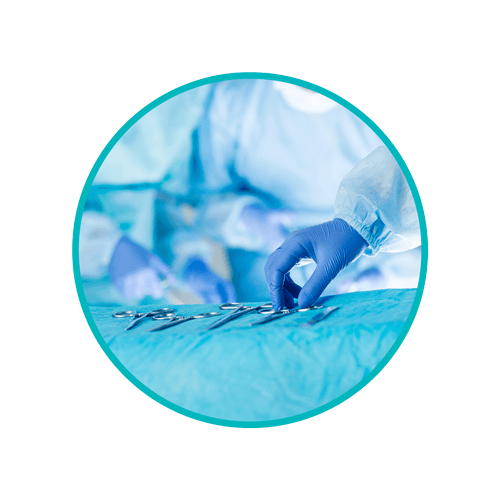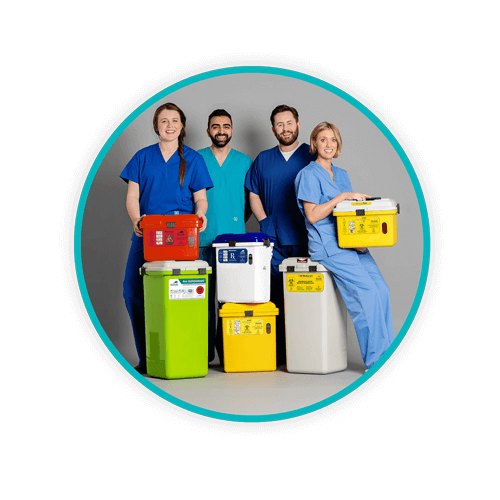What Happens to Surgical Waste?

Hospitals, surgical centres, cosmetic surgical practices, and independent physician practices generate surgical waste on a daily basis throughout Canada. What happens to it? How is it disposed of so that it doesn’t pose a danger to people or the environment? Surgical waste can contain contaminants, pathogens, and microorganisms that have a detrimental effect on others. Knowing how to dispose of surgical waste is essential.
TOPICS WE WILL COVER:
1 / What exactly is surgical waste?
2 / What about pharmaceutical surgical waste?
3 / Where does surgical waste go?
5 / Daniels Health Canada supports compliant surgical waste disposal
What exactly is surgical waste?
Surgical waste is any waste created during a surgical procedure, which can include a number of different waste streams. Examples of surgical waste can include but are not limited to:
- Biomedical waste
- Sharps
- Pharmaceutical waste
- Linens used to drape operating tables and, in some cases, personal protective equipment (PPE)
- Regular solid waste
- Recyclable plastics
-
Sterile wrappings, such as those used during a surgical procedure to promote sterilisation
It’s important to note that, depending on the composition of a specific piece of waste, the process for disposal can differ, so segregation of waste during and after the procedure will make disposal processes easier.
For example, sharps waste will immediately be placed in a sharps container that is intended for incineration, but sterile wrapping and face shields may be recyclable, depending on the scenario and contamination levels.
Solid surgical waste that is not infectious or hazardous in nature might be transported to local landfills, while biomedical waste must necessarily require other treatment processes, such as incineration.
What about pharmaceutical surgical waste?
Pharmaceutical waste (medications, anesthesia, IV bags, tubing, vials of drugs, etc.) is often created during a surgical procedure. Segregation processes will also differ in these scenarios.
For example, some pharma waste is deemed acutely hazardous and must be packaged, labelled, and disposed of separately from other types of waste. Some examples of an acute hazardous substance include Coumadin, Warfarin, nicotine patches, and arsenic trioxide.
Where does surgical waste go?
Because surgical waste can contain a variety of biomedical, pharmaceutical, and hazardous waste products, identification and segregation should be done as close to the point of origin as possible. Identifying waste for segregation is the first step. Ask yourself: Is it infectious? Is it a radioactive waste? Does it contain constituents of a potentially hazardous waste? Is it contaminated with biomedical components such as blood, body fluids, or tissues?
Guidelines for how to handle different waste streams across Canada as well as each province and territory are available online. For example, information regarding hazardous waste and recyclable materials can be found on the government of Canada website here.
Management of biomedical waste is important in not only protecting healthcare providers, but the environment. Detailed information regarding biomedical waste management processes are found in Chapter 16 (16.1) of the Canadian Biosafety Handbook. Appropriate colour-coded bags, containers, and bins are required to identify biomedical waste from other waste streams, and those containers should also contain the universal biohazard symbol.
Biomedical waste is typically sent to a biomedical waste disposal facility for incineration or steam sterilization prior to its ultimate disposal. However, depending on the type of waste material, special considerations and requirements for its disposal are applicable.
Chapter 20 of the Canadian Biosafety Handbook covers movement and transportation of infectious materials or toxins throughout Canada. Any facility performing surgical procedures should be aware that transportation of infectious substances falls under the Transportation of Dangerous Goods Act, Transportation of Dangerous Goods Regulations, and Dangerous Goods Regulations.
It is the responsibility of the waste generator to ensure that any treatment or waste facilities that transport waste off-site for disposal are approved to accept the type of waste being shipped, especially if it contains hazardous waste.
Throughout Canada’s provinces and territories, guidelines for processes in the handling of surgical waste may differ slightly. While all provinces and territories must follow the guidelines of the federal government, it is often found that the regulations of independent provinces and territories are stricter.
Surgical waste disposal
A common method for disposal of surgical waste in the past has been through incineration. However, in recent years, Canada has adopted and encouraged more environmentally friendly processes and technologies to effectively treat and disinfect a wide variety of medical wastes prior to disposal.
Over the past couple of decades, technologies have advanced, as have guidelines for waste minimisation. This is why segregation is so important. Ensuring that each type of surgical waste is placed in appropriate containers not only keeps waste streams segregated from each other, but keeps it out of “regular” trash that typically ends up in landfills.
Segregation is a cost-effective tool especially when dealing with hazardous waste, which incurs greater costs in packaging, transportation, and disposal fees. For example, “red bag” waste (biological waste) is more expensive to treat than nonregulated medical waste. Mixing different waste streams increases the volume of waste that require special treatment, especially in the case where infectious, biohazardous, or hazardous wastes are mixed together or with “regular” waste.
Daniels Health Canada supports compliant surgical waste disposal
Daniels Health Canada encourages all healthcare facilities and surgical centres to properly identify waste streams prior to disposal. It’s about more than cost savings; it’s about protecting healthcare providers, patients, the general public, and the environment. Regardless of province or territory, compliance is key to not only avoiding fines and penalties, but in protecting our environment. For more information about our products, services, and resources when it comes to surgical waste disposal, call one of our knowledgeable representatives today.
